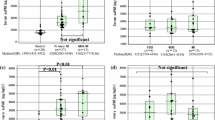Abstract
Background
Circulating levels of soluble urokinase-like plasminogen activator receptor (suPAR) have been associated with proteinuria and renal function in focal segmental glomerulosclerosis (FSGS). This study aimed to evaluate if circulating suPAR levels are independently associated with proteinuria in patients with non-FSGS glomerulonephritis.
Methods
This is a cross-sectional analysis of suPAR levels on 42 patients with primary non-FSGS glomerulonephritis (group GN) and 140 patients with secondary glomerulonephritis within an autoimmune disease (group AID).
Results
suPAR serum levels were significantly higher in AID patients (4,733 ± 3,073 pg/ml) than in healthy controls (1,908 ± 1,685 pg/ml; p < 0.001), whereas GN patients displayed intermediate levels (3,670 ± 2,435 pg/ml; p = 0.021). Multivariate analysis for elevated serum suPAR (>3,000 pg/ml) showed an independent association with estimated glomerular filtration rate (eGFR) <60 ml/min/1.73 m2 [odds ratio (OR) = 4.19, 95 % confidence interval (CI): 1.67–10.54, p = 0.002], proteinuria >0.5 g/day (OR = 2.97; 95 % CI: 1.32–6.70; p = 0.009) and presence of secondary vs. primary GN (OR = 2.87, 95 % CI: 1.25–6.23; p = 0.013). A general linear model confirmed that suPAR levels were significantly affected by proteinuria >0.50 g/day (coefficient +1,477 pg/ml), eGFR (−38 pg/ml per 1 ml/min/1.73 m2 increase) and presence of secondary vs. primary GN (+1,368 pg/ml).
Conclusions
This study shows that elevated serum suPAR levels are associated with reduced eGFR and presence of proteinuria in both primary and secondary GN, suggesting that circulating suPAR may represent a common biomarker of renal involvement in a wide spectrum of GN.
Similar content being viewed by others
References
Thunø M, Macho B, Eugen-Olsen J (2009) suPAR: the molecular crystal ball. Dis Markers 27(3):157–172
Montuori N, Ragno P (2009) Multiple activities of a multifaceted receptor: roles of cleaved and soluble uPAR. Front Biosci (Landmark Ed) 14:2494–2503
Backes Y, van der Sluijs KF, Mackie DP et al (2012) Usefulness of suPAR as a biological marker in patients with systemic inflammation or infection: a systematic review. Intensive Care Med 38(9):1418–1428
Persson M, Ostling G, Smith G et al (2014) Soluble urokinase plasminogen activator receptor: a risk factor for carotid plaque, stroke, and coronary artery disease. Stroke 45(1):18–23
Sehestedt T, Lyngbæk S, Eugen-Olsen J et al (2011) Soluble urokinase plasminogen activator receptor is associated with subclinical organ damage and cardiovascular events. Atherosclerosis 216(1):237–243
Enocsson H, Wettero J, Skogh T et al (2013) Soluble urokinase-like receptor activator levels reflect organ damage in systemic lupus erythematosus. Transl Res 162(5):287–296
Trimarchi H (2013) Primary focal and segmental glomerulosclerosis and soluble factor urokinase-type plasminogen activator receptor. World J Nephrol 2(4):103–110
Wei C, El Hindi S, Li J et al (2011) Circulating urokinase receptor as a cause of focal segmental glomerulosclerosis. Nat Med 17(8):952–960
Wei C, Trachtman H, Li J et al (2012) Circulating suPAR in two cohorts of primary FSGS. J Am Soc Nephrol 23(12):2051–2059
Alachkar N, Wei C, Arend LJ et al (2013) Podocyte effacement closely links to suPAR levels at time of posttransplantation focal segmental glomerulosclerosis occurrence and improves with therapy. Transplantation 96(7):649–656
Morath C, Wei C, Macher-Goeppinger S et al (2013) Management of severe recurrent focal segmental glomerulosclerosis through circulating soluble urokinase receptor modification. Am J Ther 20(2):226–229
Jefferson JA, Shankland SJ (2013) Has the circulating permeability factor in primary FSGS been found? Kidney Int 84(2):235–238
Welsh GI, Saleem MA (2011) The podocyte cytoskeleton–key to a functioning glomerulus in health and disease. Nat Rev Nephrol 8(1):14–21
Maas RJ, Deegens JK, Wetzels JF (2013) Serum suPAR in patients with FSGS: trash or treasure? Pediatr Nephrol 28(7):1041–1048
Naesens M, Meijers B, Sprangers B (2013) suPAR and FSGS: the gap between bench and bedside. Transplantation 96(4):368–369
Meijers B, Maas RJ, Sprangers B et al (2014) The soluble urokinase receptor is not a clinical marker for focal segmental glomerulosclerosis. Kidney Int 85(3):636–640
Huang J, Liu G, Zhang YM et al (2013) Plasma soluble urokinase receptor levels are increased but do not distinguish primary from secondary focal segmental glomerulosclerosis. Kidney Int 84(2):366–372
Wada T, Nangaku M, Maruyama S et al (2014) A multicenter cross-sectional study of circulating soluble urokinase receptor in Japanese patients with glomerular disease. Kidney Int 85(3):641–648
Sinha A, Baipal J, Saini S et al (2014) Serum-soluble urokinase receptor levels do not distinguish focal segmental glomerulosclerosis from other causes of nephrotic syndrome in children. Kidney Int 85(3):649–658
Segarra A, Jatem E, Quiles MT et al (2014) Diagnostic value of soluble urokinase-type plasminogen activator receptor levels in adults with idiopathic nephrotic syndrome. Nefrologia 34(1):46–52
Segarra A, Segarra A, Jatem E et al (2014) Value of soluble urokinase receptor serum levels in the differential diagnosis between idiopathic and secondary focal segmental glomerulosclerosis. Nefrologia 34(1):53–61
Franco Palacios CR, Lieske JC, Wadei HM et al (2013) Urine but not serum soluble urokinase receptor (suPAR) may identify cases of recurrent FSGS in kidney transplant candidates. Transplantation 96(4):394–399
Outinen TK, Mäkelä S, Huttunen R, et al. (2014) Urine soluble urokinase-type plasminogen activator receptor levels correlate with proteinuria in Puumala hantavirus infection. J Intern Med. doi:10.1111/joim.12257 (Epub ahead of print)
Acknowledgments
CM is a PhD student, whose fellowship is funded by the non-profit foundation “Fondazione De Agostini”, to which we are sincerely thankful.
Conflict of interest
This paper has been seen and approved by all authors and is not under consideration for publication elsewhere in a similar form, in any language, except in abstract form. No financial support was given to perform this study. None of the authors has a conflict of interest to disclose. None of the authors has a relationship with companies that might have a financial interest in the herein reported results.
Author information
Authors and Affiliations
Corresponding author
Electronic supplementary material
Rights and permissions
About this article
Cite this article
Musetti, C., Quaglia, M., Cena, T. et al. Circulating suPAR levels are affected by glomerular filtration rate and proteinuria in primary and secondary glomerulonephritis. J Nephrol 28, 299–305 (2015). https://doi.org/10.1007/s40620-014-0137-1
Received:
Accepted:
Published:
Issue Date:
DOI: https://doi.org/10.1007/s40620-014-0137-1





